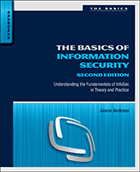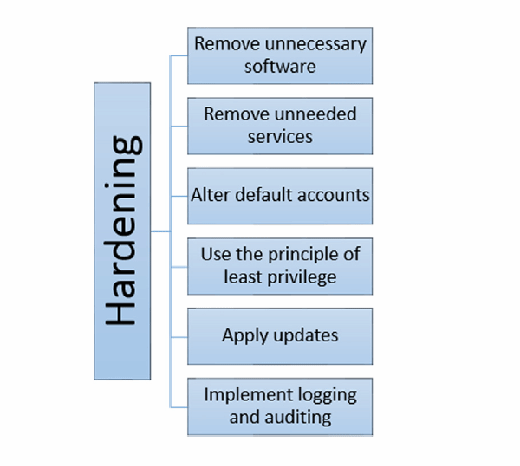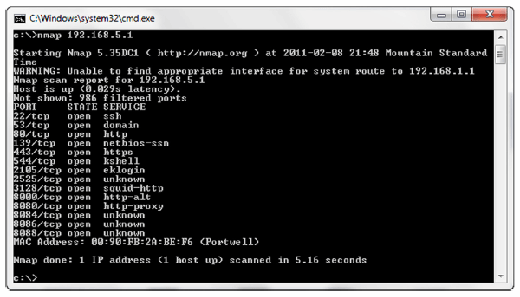The Basics of Information Security
In this excerpt of The Basics of Information Security, author Jason Andress outlines methods for improving operating systems security.
 The following is an excerpt from the book The Basics of Information Security written by Jason Andress and published by Syngress. This section from chapter 11 explains different things organizations can do to improve the security of the operating systems that host critical data, processes and applications.
The following is an excerpt from the book The Basics of Information Security written by Jason Andress and published by Syngress. This section from chapter 11 explains different things organizations can do to improve the security of the operating systems that host critical data, processes and applications.
Operating system hardening
When we look at operating system hardening, we arrive at a new concept in information security. One of the main goals of operating system hardening is to reduce the number of available avenues through which our operating system might be attacked. The total of these areas is referred to as our attack surface. The larger our attack surface is, the greater chance we stand of an attacker successfully penetrating our defenses. Each area in which we are potentially insecure adds to our attack surface, and each area in which we have applied security measures decreases it.

There are six main ways in which we can decrease our attack surface, as listed here and shown in Figure 11.1:
- Removing unnecessary software
- Removing or turning off unessential services
- Making alterations to common accounts
- Applying the principle of least privilege
- Applying software updates in a timely manner
- Making use of logging and auditing functions
Remove all unnecessary software
Alert!
We should always exercise great care when making changes to operating system settings, tools, and software. Some of the changes we might make could have unintended effects on the way our operating system functions, and a production machine is not the place to learn this through experience. Researching changes carefully and testing on lab systems before we make changes is always a good policy.
Each piece of software installed on our operating system adds to our attack surface. Some software may have a much greater effect than others, but they all add up. If we are truly seeking to harden our operating system, we need to take a hard look at the software that should be loaded on it, and take steps to ensure that we are working with the bare minimum need for a functional system.
The Basics of Information Security
Author: Jason Andress
Learn more about The Basics of Information Security from publisher Syngress
At checkout, use the discount code PBTY14 for 25% off
If we are preparing a Web server, for instance, we should have the Web server software, any libraries or code interpreters that are needed to support the Web server, and any utilities that deal with the administration and maintenance of the operating system, such as backup software and remote access tools. We should remove applications like Microsoft office or services like File Transfer Protocol (FTP). We really have no reason to install anything else if the system is truly going to function solely as a Web server.
Our problems begin to arise when we see other software installed on the machine, often with the best of intentions. For example, let us say that one of our developers logs in remotely and needs to make a change to a Web page on the fly, so they install the Web development software they need. Then they need to evaluate the changes, so they install their favorite Web browser and the associated media plug-ins, such as Adobe Flash and Acrobat Reader, as well as a video player to test the video content. In very short order, not only do we have software that should not be there, but the software quickly becomes outdated since it is not patched, because it is not "officially" installed so is not part of the configuration management plan. At this point, we have a relatively serious security issue on an Internet-facing machine.
Remove all unessential services
In the same vein as removing unneeded software, we should also remove or disable unessential services. Many operating systems ship with a wide variety of services turned on in order to share information over the network, locate other devices, synchronize the time, allow files to be accessed and transferred, and perform other tasks. We may also find that services have been installed by various applications, to provide the tools and resources on which the application depends in order to function.
Turning operating services off can be an exercise in experimentation and frustration. In many cases, such services are not named in a fashion that indicates their actual function, and tracking down what each of them is doing may require a bit of research. One of the best things to do first when we are seeking to locate such extraneous services is to determine the network ports on which the system is actually listening for network connections. Many operating systems have built-in utilities that will allow us to do this, such as netstat on Microsoft operating systems, but we can also put Nmap to use for such tasks.
As we discussed in Chapter 10, Nmap can allow us to discover the devices on our networks, but it can also allow us to determine on which network ports a given system is listening. If we run the following Nmap command:
Nmap <IP address>
we will see results similar to those shown in Figure 11.2.

In this case, we can immediately point out several common services running on the target:
- Port 22 Remote access to the system, secured with Secure Shell (SSH)
- Port 53 Domain name system (DNS), which translates friendly names to IP addresses
- Port 80 Hypertext Transfer Protocol (HTTP), which serves Web content
- Port 443 Hypertext Transfer Protocol Secure (HTTPS), which serves Web pages secured with Secure Sockets Layer (SSL) and/or Transport Layer Security (TLS)
Several other ports are open as well, running various services. We can use this information as a starting place for closing down undesirable services. In the case of our example target, ports 22, 80, and 443 being open might be notable if we did not intend to allow remote access or serve Web content.
Alter default accounts
A common weakness in many operating systems is the use of accounts known to be standard. In many operating systems (as well as some applications), we can find the equivalent of a guest account and an administrator account. We may also find a variety of others, including those intended for the use of support personnel, to allow services or utilities to operate, and a plethora of others, widely varying by the operating system vendor, version, and so forth. Such accounts are commonly referred to as default accounts.
In some cases, the default accounts may come equipped with excessively liberal permissions to regulate the actions they are allowed to carry out, which can cause a great deal of trouble when they are being used by an informed attacker. We may also find that default accounts are set with a particular password or no password at all. If we allow such accounts to remain on the system with their default settings, we may be leaving the proverbial doors that protect access to our system wide open so that attackers can simply stroll right in and make themselves at home.
Typical measures we would take to mitigate such security risks are generally very simple to carry out. We should first decide whether the accounts are needed at all, and disable or remove any we will not be using. In the case of guest accounts, support accounts, and others of a similar nature, we can often quickly and easily turn the accounts off or remove them entirely without causing problems for ourselves. In the case of administrative accounts, often with names such as administrator, admin, or root, we may not be able to safely remove them from the system, or the operating system may prevent us from doing so. In most cases, however, such accounts can be renamed in order to confound attackers who might attempt to make use of them. Lastly, we should not leave any account with a default password, no matter what its status; as such passwords are often documented and well known.
Apply the principle of least privilege
As we discussed in Chapter 3, the principle of least privilege dictates that we only allow a party the absolute minimum permission needed for it to carry out its function. Depending on the operating system in question, we may find this idea put into practice to a greater or a lesser extent. In almost any modern operating system, we can find the tasks a particular user is allowed to carry out separated into those that require administrative privileges and those that do not.
In general, normal operating system users are allowed to read and write files, and perhaps execute scripts or programs, but they are limited to doing so within a certain restricted portion of the file system. Normal users are generally not allowed to carry out tasks such as modifying the way hardware functions, making changes to the files on which the operating system itself depends, and installing software that can change or affect the entire operating system. Such activities are generally restricted to those users that are allowed administrative access.
On most UNIX and Linux-like operating systems, we can often see such roles strictly enforced. Although it would be possible for the administrator of such a system to allow all users to act with the privileges of an administrator, this is generally not the convention and administrative or "root" access is often guarded carefully. On Microsoft operating systems, we can often find the exact opposite to be true. On a windows system the default is to give users more control, so care needs to be taken to change permissions to be more restrictive. While there are more threats focused on MS due to the fact they have larger market share, the security posture for any system is based on the administrator. The same paradigm exists between Apple IOS and Android IOS in the smartphone market.
When we allow the average system user to regularly function with administrative privileges, we leave ourselves open to a wide array of security issues. If the user executes a malware-infected file or application, he does so as the administrator and that program has considerably more freedom to alter the operating system and other software installed on the host. If an attacker compromises a user's account, and that account has been given administrative rights, we have now given the keys to the entire system directly to the attacker. Nearly any type of attack we might discuss, launched from nearly any source, will have considerably more impact when allowed access to administrative rights on a host. Thus one of the first actions a hacker will take if they break in via a user account is privilege escalation. It is important to monitor admin accounts for misuse!
If, instead, we limit the privileges on our systems to the minimum needed in order to allow our users to perform their required tasks, we go a long way toward mitigating many security issues. In many cases, attacks will fail entirely when an attacker attempts to run them from a user account running with a limited set of permissions. This is a very cheap security measure we can put in place and is simple to implement. Many users will complain about the inability to install new software, so it is key to have policy supporting this practice and ensure users understand the reason for the policy.
Perform updates
Regular and timely updates to our operating systems and applications are critical to maintaining strong security. New attacks are published on a regular basis, and if we do not apply the security patches released by the vendors that manufacture our operating systems and applications, we will likely fall victim very quickly to a large number of well-known attacks.
We can look to the various items of malware propagating over the Internet at any given time as an excellent example of this idea. Many pieces of malware are able to spread by exploiting known vulnerabilities that have long since been patched by the software vendors. Although it does pay to be prudent when planning to install software updates and to test them thoroughly before doing so, it is generally unwise to delay this process for very long.
Read an excerpt
Download the PDF of chapter 11 to learn more!
One of the most crucial times to ensure that we have properly patched a system is directly after we have finished installing it. If we connect a newly installed and completely unpatched system to our network, we may see it attacked and compromised in very short order, even on internal networks. The commonly considered best practice in such a situation is to download the patches onto removable media and use this media to patch the system before ever connecting it to a network. Part of solid configuration management program is to monitor patch announcements. There are services that will do this for you. You must also consider auto patching for systems like your home computer. Patching is one of the most important parts of your security program (even it is part of the IT department function).
Turn on logging and auditing
Last, but certainly not least, we should configure and turn on the appropriate logging and auditing features for our system. Although the particulars of how we configure such services may vary slightly depending on the operating system in question, and the use to which the system is to be put, we generally need to be able to keep an accurate and complete record of the important processes and activities that take place on our systems. We will generally want to log significant events such as the exercise of administrative privileges, users logging in to and out of the system, or failing to log in, changes made to the operating system, and a number of similar activities taking place. For a simple Windows OS, there are over 200 security-related logs that can be turned on so it is important to find the right balance of logs and storage. Key logs should be tied to alerts and a monitoring program.
Depending on the environment into which we will be placing the system, we may also want to include additional features to supplement the tools built into the operating system for these purposes. We may want to install a variety of monitoring tools that watch the functionality of the system and alert us to issues with the system itself or anomalies that might show in the various system or application logs. We might also want to install supplementary logging architecture in order to monitor the activities of multiple machines or to simply allow duplicate remote copies of logs to be maintained outside the system to help ensure that we have an unaltered record of the activities that might have taken place on the system.
In addition to the hardening methods discussed above, there are a number of specific hardening standards. Some of the more commonly discussed are the Security Technical Implementation Guides (STIGs) from the US Defense Information Systems Agency (DISA) and the hardening guidelines available from the US National Security Agency (NSA).
It is also important to note that while logs are key to a post event investigation, actually reviewing the logs is a vital part of the process. If we collect logs but never review them we will miss detecting attacks early and suffer much greater overall impact.
Protecting against malware
A large concern at present is the mind-boggling number and variety of malware present on the networks, systems, and storage devices around the globe. Using such tools, attackers can disable systems, steal data, conduct social engineering attacks, blackmail users, gather intelligence, and perform a number of other attacks.
A good example of a particularly complex and impactful item of malware to examine is Stuxnet. Stuxnet was first discovered in July 2009, albeit in a somewhat weaker form than what it ultimately reached [2]. Although the number of systems infected with it was much lower in comparison to some of the other major malware outbreaks that have taken place over the years, it had a much more specific focus in that it targeted the Supervisory Control and Data Acquisition (SCADA) systems that run various industrial processes. In the case of this attack, it was a nation state attacking another nation state's military capability.
Additional resources
For considerably more details on what Stuxnet does and how it does it, see the "W32.Stuxnet Dossier" from Symantec, available at www.symantec.com/content/en/us/enterprise/media/security_response/whitepapers/w32_stuxnet_dossier.pdf.
The ultimate goal of Stuxnet appears to have been the sabotage of SCADA systems, largely targeted at portions of the equipment running in the nuclear program in Iran [3]. Stuxnet has raised the bar for malware from largely being a virtual-based attack to actually being physically destructive.
Anti-malware tools
Most anti-malware applications detect threats in the same way the IDS we discussed in Chapter 10 do: either by matching against a signature or by detecting anomalous activities taking place. Anti-malware tools do tend to depend more heavily on signatures than on anomaly detection, which is typically referred to in the anti-malware field as heuristics. Malware signatures are usually updated by the vendor of the application at least once a day and may be updated more often than that if the need arises.
Anti-malware tools generally detect malware in one of two main ways: either by detecting the presence of, or traffic indicative of, malware in real time or by performing scans of the files and processes already in place on the system. When malware is found, responses by the anti-malware tool may include killing any associated processes and deleting the files, killing the processes and quarantining the files so that they are not able to execute but are not deleted, or simply leaving whatever has been detected alone. Leaving the files intact is not a typical response but may be required as anti-malware tools do sometimes detect security tools and other files that are not malware, which we may want to leave alone and ignore in the future.
We can find anti-malware tools deployed on mobile devices, individual systems, and a variety of servers but monitored at the enterprise level as a matter of course for large enterprise environments in order to protect these systems. We may also find such tools installed on proxy servers in order to filter malware out of the incoming and outgoing traffic. This is very common in the case of proxies for e-mail, as many items of malware use e-mail as a method of propagation. In the case where malware is detected by such a tool, we may see the e-mail rejected entirely, or we may merely see the malware stripped out of the message body or the offending attachment removed.
Executable space protection
Executable space protection is a hardware- and software-based technology that can be implemented by operating systems in order to foil attacks that use the same techniques we commonly used in malware. In short, executable space protection prevents certain portions of the memory used by the operating system and applications from being used to execute code. This means classic attacks such as buffer overflows that depend on being able to execute their commands in hijacked portions of memory may be prevented from functioning at all. Many operating systems also use address space layout randomization (ASLR) [4] in order to shift the contents of the memory in use around so that tampering with it is even more difficult.
More advanced
A buffer overflow attack works by inputting more data than an application is expecting from a particular input -- for example, by entering 1000 characters into a field that was only expecting 10. Depending on how the application was written, we may find that the extra 990 characters are written somewhere into memory, perhaps over memory locations used by other applications or the operating system. It is sometimes possible to execute commands by specifically crafting the excess data.
Executable space protection requires two components to function: a hardware component and a software component. Both of the main CPU chip manufacturers, Intel and AMD, support executable space protection, with Intel calling it the Execute Disable (XD) bit [5] and AMD calling it Enhanced Virus Protection [6].
The software implementation of executable space prevention can be found in many common operating systems. Both executable space prevention and ASLR can be found in many operating systems from Microsoft and Apple, as well as a number of Linux distributions, just to name a few.
Software firewalls and host intrusion detection
In addition to the tools we can use on the network to detect and filter out undesirable traffic, such as firewalls and IDS, we can add another layer of security at the host level by implementing a very similar set of tools here. Although we may often find firewalls and IDS implemented at the network level in the form of purpose-built appliances, the actual functions they perform are generally carried out via specialized software resident on the devices. Similar software can be installed directly onto the hosts residing on our networks.
Software firewalls
Properly configured software firewalls are a very useful additional layer of security we can add to the hosts residing on our networks. Such firewalls generally contain a subset of the features we might find on a large firewall appliance but are often capable of very similar packet filtering and stateful packet inspection. We often find the rulesets of such applications expressed in terms of the particular applications and ports allowed to send and receive traffic on the various network interfaces that exist on the host. Such softwares can range from the relatively simple versions that are built into and ship with common operating systems, such as Windows and OS X, to large versions intended for use on corporate networks that include centralized monitoring and the capability for considerably more complex rules and management options.
Host intrusion detection
HIDS are used to analyze the activities on or directed at the network interface of a particular host. They have many of the same advantages as network-based intrusion detection systems (NIDS) have but with a considerably reduced scope of operation. As with software firewalls, such tools may range from simple consumer versions to much more complex commercial versions that allow for centralized monitoring and management.
A potential flaw with centrally managed HIDS is that, in order for the software to report an attack to the management mechanism in real time, the information needs to be communicated over the network. If the host in question is being actively attacked via the same network we would report over, we may not be able to do this. We can attempt to mitigate such issues by sending a regular beacon from the device to the management mechanism, allowing us to assume a problem if we stop seeing multiple devices unexpectedly, but this might not be a complete approach.
About the author:
Jason Andress (ISSAP, CISSP, GPEN, CEH) is a seasoned security professional with a depth of experience in both the academic and business worlds. Presently he carries out information security oversight duties, performing penetration testing, risk assessment, and compliance functions to ensure that critical assets are protected. Jason has taught undergraduate and graduate security courses since 2005 and holds a doctorate in computer science, researching in the area of data protection. He has authored several publications and books, writing on topics including data security, network security, penetration testing, and digital forensics.





